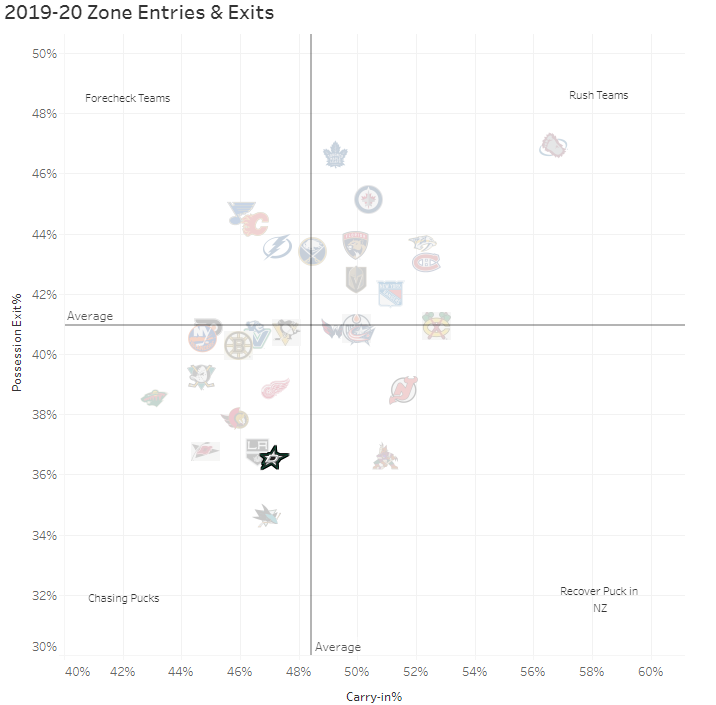Team Identity: Dallas' Snow Plow Offense
How the Stars make the most of their rush opportunities
Truth be told I’ve long held off discussing the Dallas Stars’ system because, frankly, I find it incredibly uninteresting.
DAL in a nutshell
1-1-3 or 1-2-2 passive in the neutral zone
2-3 forecheck in the offensive zone
Low-to-high plays in the OZ with heavy net presence
Five-tight in the defensive zone
Not much new to write home about.
2019-20 Regular Season
Unsurprisingly Corey Sznajder’s tracking data suggest that Dallas is just your run-of-the-mill NHL team.
During the regular season the Stars plotted out as a typical dump-and-chase team most similar to the L.A. Kings and the Carolina Hurricanes.
Earlier in the Team Identity series Corey and I broke down how Carolina used “chip & charge” tactics to build offensive-zone pressure and tilt the ice in their favor. It certainly can be an effective way to get up-ice and create chances.
Because of their passive neutral-zone structure, Dallas wasn’t especially good at denying their defensive blue line. Their offensive transition results were middling as well.
In contrast the Vegas Golden Knight performed significantly better in the regular season, carrying the puck in more frequently and denying more rushes at their blue line.
Enter the Plow King
Despite my lukewarm feelings about the team, at the time of writing the Stars are only a game away from reaching the Stanley Cup finals.
After taking down the best transition-offense team in the NHL (the Colorado Avalanche, portrayed here by Homer Simpson) in the previous round, the Stars have the favored Golden Knights on the ropes.
How?
It certainly helps that backup goaltender Anton Khudobin has been superb, stopping 95.2% (119/125) of shots through the first four games of the DAL-VGK series.
But also working in Dallas’ favor is how the team consistently activates four players on their counter-attacks:
Against the Golden Knights, Stars defensemen Miro Heiskanen, John Klingberg and even Jamie Oleksiak have been able to quickly switch their mindset from “contain” to “attack” on changes of possession in the defensive zone.
After stopping Vegas’ three-man cycle, Dallas’ defensemen habitually activate through the middle of the ice, sprint past their check, and join their forwards on the rush as the F4.
Against the run of play, the Stars are able to plow through the neutral zone simply by throwing more manpower at the problem: What used to be a 2v2 dump-in is now a 3v2 outside carry-in. What used to be a 3v3 is now a 4v3, with the potential for developing into something more.
Dallas’ DNA is more brute force than high-end skill. But it’s difficult to argue with the results so far - pending Khudobin’s performance in net the rest of the way, of course.
The last sequence in the video above (0:42) also illustrate a way Vegas can turn the tables against DAL’s snow plow rush: position F3 higher in the zone in a Tampa-esque 2-3 OZP, force a turnover on a Stars counter-attack, then counter-the-counter and attack Khudobin’s net from the middle of the ice.
A guide for the modern coach: “Hockey Tactics 2020”:
If you enjoy this newsletter and want to see more free content, consider ordering a copy of my e-book Hockey Tactics 2020, edited by a legendary journalist and illustrated by an artist whose work you have surely already seen. Eight chapters, more timely insights, more timeless principles. Get it now







